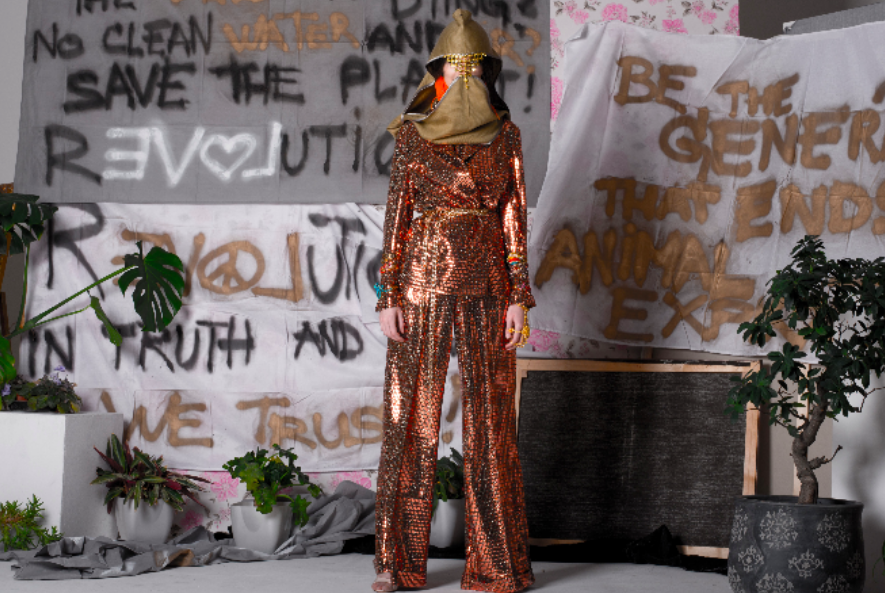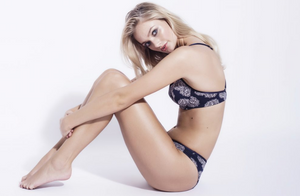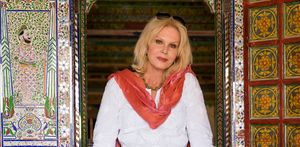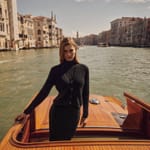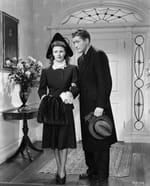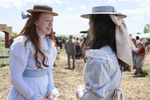
Sustainable journalist and editor, Alison Jane Reid, in conservation with Jiri Kalfar, ballet dancer turned glittering, fashion revolution designer. If fashion is all about the celebration of freedom, innovation and self-expression, then Jiri Kalfar is to fashion what Picasso is to art: a fashion agent provocateur, who uses beauty and sublime, artisanal craftsmanship to challenge the status quo and change ideas.
The self-taught, enfant terrible of fashion, chains himself to Czech government buildings, to protest against animal farming and the fur industry, while handcrafting twinkling, sustainable fashion masterpieces in his Prague studio. His extrovert, international gypsy designs draw on the fluidity of dance, the molten allure of old Hollywood and the traditional folk motifs of his Eastern European heritage. Glamour, opulence, juxtaposition and playfulness are the hallmarks of Jiri Kalfar, from a faux fur, Tsarina skating jacket – to the return of the Ziggy Stardust, Studio 54 trousersuit, with a dash of Garbo glitter, sensuality and fin de siecle elegance.
His collections attract the patronage of the modern A list goddess from Karolina Kurkova to Krissy Tiegan and Louisa Johnson, to name just a few of his fashion disciples. Drawing on his career in dance and his many travels, Jiri Kalfar’s winter 2017/18 collection appeals equally to a duchess or a rock star. How exciting to think there is no excuse for the A list not to embrace fashion revolution!

1.Can luxury fashion and activism go hand in hand?
I think it can. At the end of the day, what is luxury? To me luxury is to have the choice. It is knowledge. At Jiri Kalfar, we offer luxury with the idea of compassion, ethics and sustainable values. Luxury is to be able to own unique pieces, which are crafted, in house and very few garments are made. It is an option. Fashion is about self expression. It only needs to be viewed at from the right perspective.
2.Does your former life as a ballet dancer inspire the way you design your collection?
Ballet in many ways, is not a job, it is more of a lifestyle. You get know your physical and your mental side. You often have to go deeper, to give the close to perfect result. Deeper into your physical abilities but your mental ones too. I gained a great knowledge of the human body, of its possibilities, angles and curves. In addition, l learned that it always has to look natural. This is what I want to project into my clothes and collections..
- If you were an animal what would you be and why?
My sign is a leo, so a lion maybe. My friends always tell me that I act like a cat. Or a panda, I love pandas.

4.How does your culture and heritage inspire what you create as a designer?
I’ve travelled a lot and lived in different countries and continents since I was 15. I came back to the Czech Republic because I love Prague and I missed the life here. That was after 9 years abroad when I lived, studied and worked in Germany, Italy, Spain, New York City and others… I think travel has been my biggest influence. We live in such a global world that heritage and culture is becoming more and more connected. And the true heritage, which scarily we start to lose, is our planet. That is what we all have in common, despite our political beliefs, religions, genders, it is our common heritage. It is something we should protect and care for. We live in a digital age when information is quicker and easier to gain but it seems like we use it for the wrong reasons, and act like everything will always be the same. What I always ask is, what will be the heritage and legacy of my generation to the next? And I think that influences me as a designer too. To share a message, to use my work, to raise questions and try to make it better. To share awareness. It influences me not only in the esthetic of my collections, but also in trying to create my products in the most ecological and sustainable way.
5.Describe your working day?
The reality is not that exciting. I like regularity, so I go to my studio every day. It is only 10 minutes from where I live, so I walk. I have everything in the same place, my office, our showroom, workroom, where we do the clothes, photo studio. We do everything in house, and that setting allows me to do more things simultaneously. I have my own brand, which boringly requires lots of admin stuff, of dealing with suppliers, clients, shops. I do my own accounting too, answer emails and take care of social media. So that takes majority of my day. But because our work room is in the same place, I can work on the collections and the creative side of the business at the same time. It is nice balance of administration and creativity.

I like to spend the weekends out of the city, with my family. With our dog, do some gardening, reading. I never thought I would enjoy such things, but the tranquillity of it, helps me to think, and get things in order and in perspective. I do constantly think about the next steps, plans, strategy, design…
6.What turned you into an animal activist? Do you have pets?
I grew up around animals. I lived in the village with pigs, sheep, cows, dogs and hens. But I think the real change in thinking happened spontaneously with time. I first started to be vegetarian, not because I don’t think humans should not eat meat but because the system is wrong. I did not want to participate in this industrial farming industry. I don’t think I ever noticed anything when I was little because I saw happy animals in the fields, enjoying the sunshine, having babies, feeding on the grass and having a normal life. It only occurred to me when I moved to the city and saw the overload of meat in supermarkets. There were chicken breasts for sale that were bigger than the actual chicken I knew. I started to find information, educate myself on the issue, and I have been shocked about what animal meat farming and fur farming actually is. It is un-human and uncontrolled. It doesn’t have a logic or justification.
I am not naive. I know that as one person I don’t make a difference; but it is my belief we should live to become the best we possibly can. To truly matter means not to harm.
As a fashion designer, I am part of an industry, which is one of the most polluting, animal harming and wasteful industries on the planet. And that I can change. I can be part of the change. I can at least speak up about the need to change. One by one, we can actually make a difference to the fashion industry.
Fashion is important. It is self-expression, it is freedom, it is statement. It is visualisation of a time, of an era, of politics even. But it should not be only about the commercial side, it should make sense too.

7.Which female icon would you most like to dress?
Vanessa Paradis for sure .
8.What is more important? Great taste or creating a spectacle?
Is there a difference? Spectacle without great taste is just really just trashy and vulgar. And great taste without spectacle is a wasted effort.
9.Do you view designing differently, coming from a dancing and modelling background?
Different to who? I was always overwhelmed by design. At the end of the day, the ballet costumes are the most worked through pieces of art. They are beautiful and practical. They are unique, even edgy sometimes. I love theatre costumes, there is so much knowledge that goes into creating one. They need to speak to the audience without the words, they are introducing a person, describing his or her role and character.
So I don’t think I view it differently. We all put on a uniform in some way. A costume, every morning, before we go to work, depending on how we want to be received, or what mood we are in. It says a lot even before you speak. There are similarities to theatre in that way.

- How do you want your clients to feel when they wear your designs?
Powerful. Strong. Unique. I want other people to be afraid of them; for their ability to stand out from the crowd. I want them to be able to express themselves. The clothes they wear should go hand in hand with their personality, and should not take from it. I don’t want my clients to hide behind the clothes, but rather to enhance their persona.
13. Your designs mix folk art and references from an age of elegance and formality – do you like to juxtapose
the two?
Actually I do. I can never be inspired only by one thing. I am bohemian, a traveller, a gypsy at heart. There are so many things which I like, I mean inspiration is everywhere. I love opera; but I like rock music too. I love ballet, but I like kabuki theatre too. I look into the past to imagine how the future will be. I follow politics but read Dostojevskij. That is what excites me, the variety. The only thing which truly bores me is minimalism. Life is too short for that.

- What inspired the military theme?
It actually wasn’t a military theme. I wanted to show the importance of the individual. To show that whatever is your fight, it is worth fighting for it, if you believe in the cause. Without any violence. The power of principle and long-term believe is stronger than a gun. Because true change only happens with time, you cannot force it on people.
- Where are your garments made? Do you use sustainable supply chains? Where do you source your opulent, ravishing fabrics?
If there are fabrics we can make ourselves, we make them ourselves in Prague. From hand-woven fabrics, to prints, recycled fabrics, lace and embroidery. It is all done locally. Some I get from suppliers in London. Some we use again and again, if there are left-over fabrics from previous collections. As I said earlier, we do make all the garments in house though, which obviously is more time consuming, but I believe in ethical labour. I can tell you the exact journey of each garment from fabric to final product.
- What era in fashion most inspires you?
So many. Again I cannot decide, I like something from each. Even the 80’s.
- Did you make clothes when you were growing up?
I would not say make. I adjusted them. Firstly, as a kid, I was often inheriting clothes either from my cousins or neighbours kids. It didn’t really matter if it was boy or girl, or if they fit as long as they could still be used. I used to adjust them. Draw on them, cut them, dye them. I enjoyed that very much. My nana and my mum used to knit me jumpers. My favourite jumper was actually the one nana knitted me. I had so many photographs with me on wearing it. It was normal. I got new clothes for birthdays and Christmas of course.

- Do you come from a creative background
If you mean artistic, then no. Everybody in my family has pretty regular jobs, from nurse to plumber or a builder. But as kids, we used to play outside so much, creating games for ourselves, drawing, dancing. We used to prepare shows for our parents, where we did our stage, costumes, screenplays… It kept us quiet and productive actually.
- Where do you like to go to experience glamour?
I find glamour in architecture and interior design, art deco and art nouveau, in theatre. There is not much glamour in fashion these days.
- What are your ambitions for your fashion house?
I just like doing what I am doing. I am a very ambitious person though, so the sky is the limit.
Interview Alison Jane Reid. Copyright June 2017.
For More Information on Jiri Kalfar, visit the website – Jiri Kalfar

